- What is a Likert Scale?
- How to Use the Likert Scale in Surveys
- How to Write Likert Scale Questions
- Choosing Response Options: Unipolar vs Bipolar Scales
- Understanding Central Tendency and Dispersion in Likert Scale Responses
- Likert Scale Analysis: Analyzing and Interpreting Likert Scale Data
- Advanced Models for Analyzing Likert Scale Data
- Likert Scale Analysis: Benefits & Limitations
- Conclusion
- Frequently Asked Questions (FAQs)
Likert Scale Explained (With Examples): Learn To Use This Popular Survey Tool
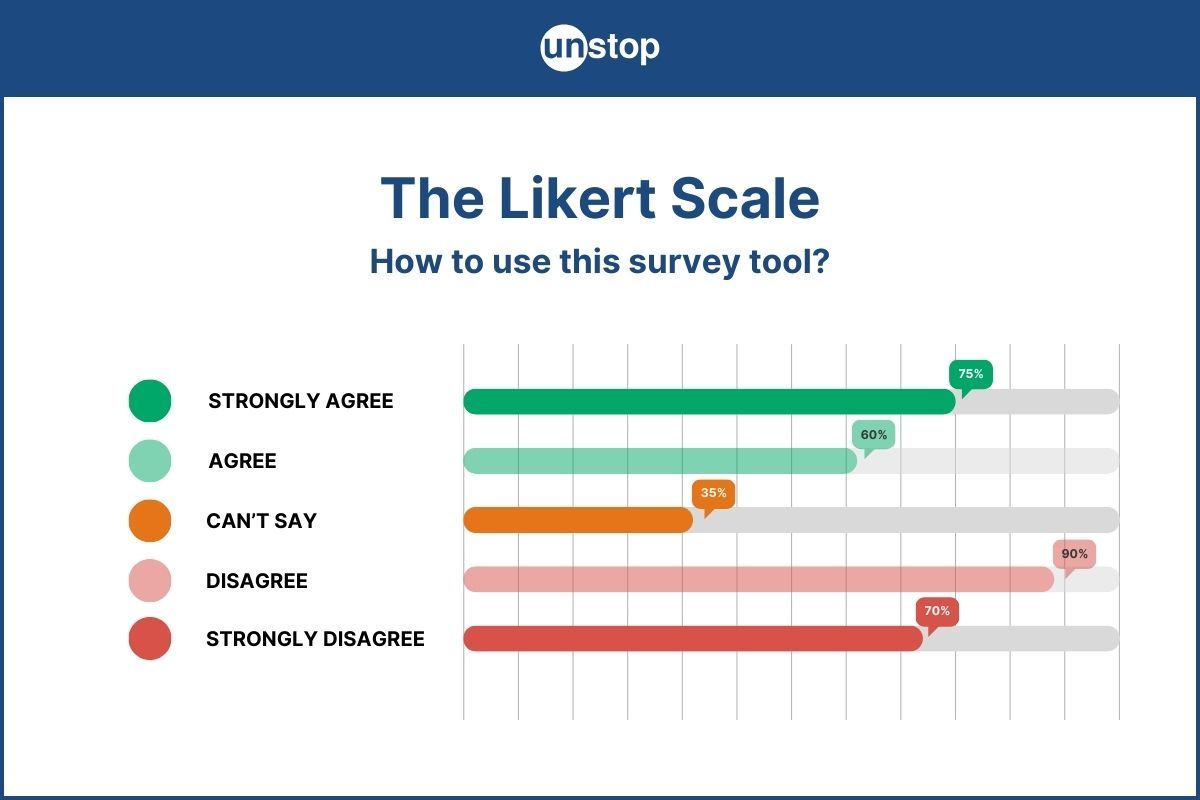
We all know that surveys can provide valuable insights into people's attitudes and opinions. However, the quality of information collected also depends on the tools used. One such popular survey tool is the Likert scale. It's a widely used rating scale that helps researchers analyze subjective data quantitatively.
So, let's dive in and learn more about the Likert scale and how it can be used to gather valuable information.
What is a Likert Scale?
The Likert scale is a widely used rating scale in surveys, providing valuable insights into respondents' attitudes and opinions on specific topics. By utilizing a series of statements and response options, the Likert scale allows for quantitative analysis of subjective data. This scale, often referred to as a point Likert scale, employs an ordinal measurement approach, enabling the ranking of responses based on their level of agreement or disagreement.
Researchers use Likert scales to measure various constructs such as attitudes, opinions, perceptions, and preferences. The scale's versatility and simplicity make it an essential tool in social science research. However, it is crucial to consider potential limitations such as social desirability bias and the assumption of equal intervals between response categories.
Likert Scale: Types
There are broadly two types of Likert scale: a 5-point Likert scale and a 7-point Likert scale.
The main difference between them is the number of response options. While a 5-point Likert scale provides five response options ranging from "Strongly Disagree" to "Strongly Agree," a 7-point Likert scale offers seven response options, allowing for more nuanced responses.
How to Use the Likert Scale in Surveys
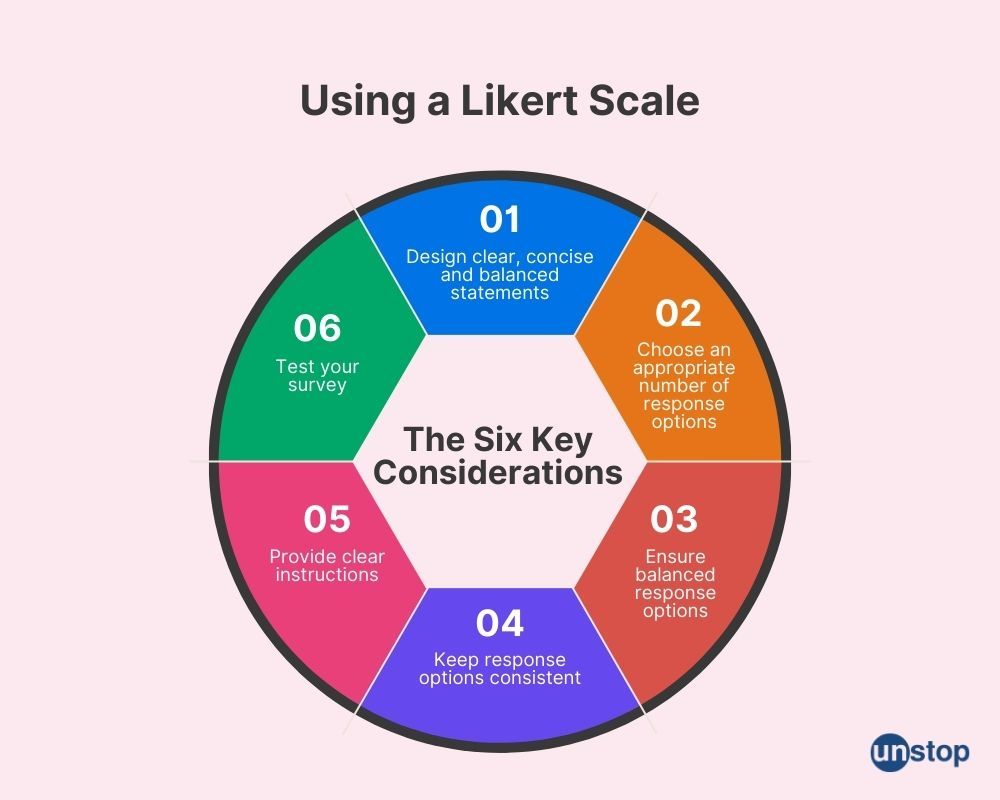
To effectively use the Likert Scale in surveys, there are a few key considerations to keep in mind:
Design Clear and Concise Statements
When creating survey questions using the Likert Scale, it is crucial to design statements that are clear and concise. This ensures that respondents can easily understand and provide accurate responses. Avoid using complex or ambiguous language that may confuse participants. Instead, opt for straightforward statements that reflect the desired information.
Choose an Appropriate Number of Response Options
Selecting the right number of response options is essential for a Likert Scale survey. Generally, it is recommended to have between 5 to 7 response options. This range provides enough variety for respondents to express their opinions effectively without overwhelming them with too many choices.
Ensure Balanced Response Options
When constructing a Likert Scale survey, it's important to ensure that the response options are balanced and cover the entire spectrum of opinions. This means offering both positive and negative response options, as well as neutral or undecided choices, if applicable. A well-balanced scale allows for more accurate data collection and analysis.
Keep Response Options Consistent
Maintaining consistency in response options throughout your Likert Scale survey is crucial for reliable data collection. Ensure that each question follows the same format and uses consistent wording for all response options provided. This consistency helps avoid confusion among participants and allows for easier interpretation of results.
Provide Clear Instructions
Alongside your Likert Scale questions, it's important to provide clear instructions on how respondents should interpret and answer each statement. Clearly state whether higher values indicate agreement or disagreement with the statement, ensuring participants understand how to navigate the scale effectively.
Test Your Survey
Before distributing your Likert Scale survey, it is crucial to test it with a small group of participants. This allows you to identify any potential issues or confusion in the wording, response options, or instructions. Testing helps ensure that your survey is clear, concise, and effectively captures the desired information.
By following these guidelines, you can effectively utilize the Likert Scale in surveys to collect valuable data and insights from respondents.
How to Write Likert Scale Questions
The two key considerations when writing Likert Scale Questions are - ensuring clarity and maintaining balance.
When writing Likert scale survey questions, use straightforward language that is easy for your survey respondents to understand. Avoid using jargon or technical terms that may confuse them. Remember, the goal is to gather accurate and meaningful data, so clarity is key.
Additionally, to ensure the effectiveness of your Likert scale questionnaires, use balanced statements that do not influence the respondent to give a particular answer.
Important Note: Before launching your survey, it's crucial to test your Likert scale questions. Conducting pilot tests with a small group of participants helps identify any issues with wording, clarity, or bias. Based on the feedback received, refine your questions until they are clear, concise, and unbiased.
Examples of Likert Scale Questions for Employee Engagement
Here are some examples of effective Likert scale questions that can be used to measure employee engagement:
"On a scale of 1 to 5, how satisfied are you with your current work environment?"
-
The information garnered from this question can be valuable for employers and managers to understand the general sentiment of their workforce and identify areas for improvement.
"To what extent do you feel valued by your superiors? Rate from strongly disagree to strongly agree."
-
By using this question, organizations can gain insights into the effectiveness of leadership in making employees feel valued.
"How motivated are you to achieve your goals within this organization?"
-
Organizations can utilize this likert scale survey question to identify areas where they may need to enhance motivation and support for employees.
By incorporating these Likert scale questions into employee surveys, organizations can gather valuable feedback regarding employee engagement. These responses help employers understand the strengths and weaknesses within their workplace culture and make informed decisions about areas that require improvement.
For instance, if a majority of respondents rate low satisfaction with their work environment, it may indicate issues such as poor communication, lack of resources, or inadequate facilities. On the other hand, high ratings for feeling valued by superiors could signify effective leadership practices and a positive work environment.
Likert scale questions are versatile and can be adapted to various domains. They are not limited to employee engagement surveys but can also be used in customer service evaluations, event feedback assessments, or health education programs. The key is to tailor the questions to the specific context and objectives of the survey.
Choosing Response Options: Unipolar vs Bipolar Scales
One important consideration is the choice between unipolar and bipolar scales. These two types of scales differ in the range of response options they offer and can have an impact on the data collected.
Unipolar Scales: Only Positive Response Options
Unipolar scales are characterized by having only positive response options. This means that respondents can only choose from options that reflect varying degrees of agreement or satisfaction. For example, a unipolar scale for measuring customer satisfaction may include response options such as "not at all satisfied," "somewhat satisfied," and "extremely satisfied."
Pros:
- Simplifies the response options by focusing solely on positive sentiments.
- May be suitable when assessing attitudes or perceptions where negative responses are less relevant.
Cons:
- Lacks negative response options, potentially limiting the expression of dissenting opinions or dissatisfaction.
- Does not capture nuances in responses that fall outside of positive sentiments.
Bipolar Scales: Including Positive and Negative Response Options
On the other hand, bipolar scales encompass both positive and negative response options. Respondents are presented with a wider range of choices that span from strong disagreement to strong agreement or from extreme dissatisfaction to extreme satisfaction. An example of a bipolar scale could be one used to measure political ideology, with response options like "strongly disagree," "neutral," and "strongly agree."
Pros:
- Allows for capturing both positive and negative sentiments, providing a more comprehensive view.
- Enables respondents to express a wider range of opinions and feelings.
Cons:
- The inclusion of negative response options may introduce a potential bias towards negativity.
- Requires careful consideration to ensure proper interpretation of neutral or middle responses.
The choice between unipolar and bipolar scales ultimately depends on research objectives and desired data outcomes.
Understanding Central Tendency and Dispersion in Likert Scale Responses
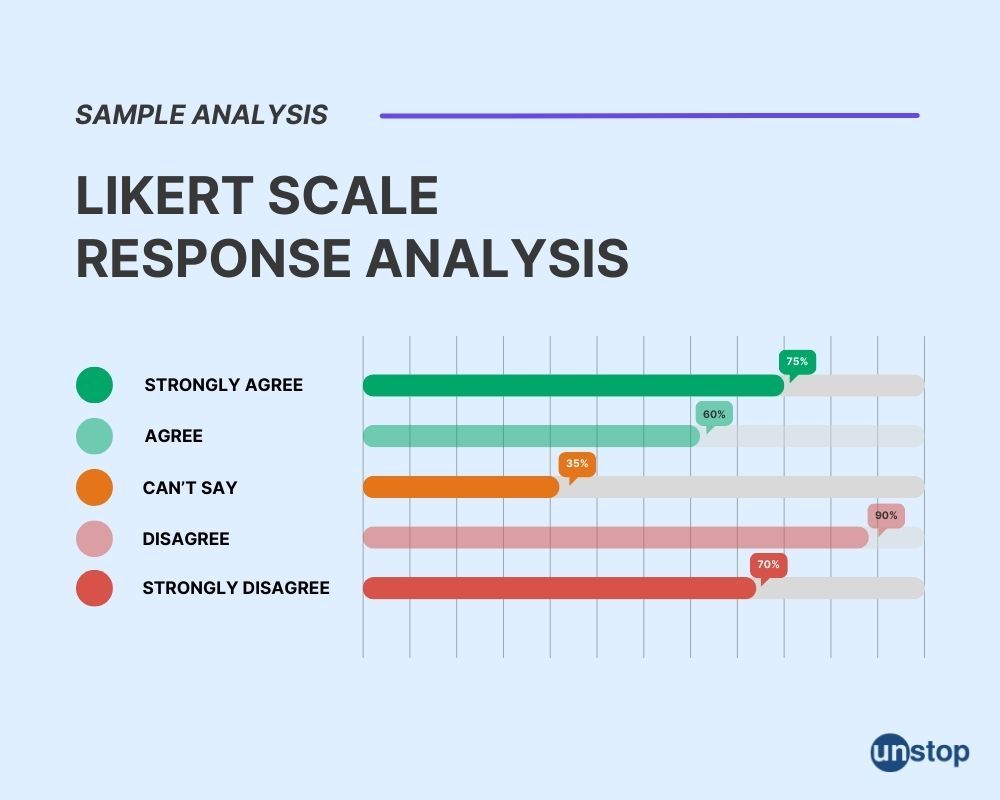
Central tendency and dispersion are essential concepts for evaluating Likert Scale Responses. Here’s why:
Central Tendency: Getting to the Heart of It
Central tendency provides us with a measure of where most respondents fall on the Likert scale. It helps us understand what is considered the "typical" response. There are several measures used to determine central tendency:
- Mode: The mode represents the most common response or category chosen by respondents. It is determined by identifying which option appears most frequently in the data.
- Median: The median is the middle value in a set of responses when they are arranged in ascending or descending order. This measure is useful when dealing with skewed distributions, as it is less affected by extreme values.
- Mean: The mean, also known as the average, is calculated by summing up all individual responses and dividing it by the total number of respondents. It provides an overall representation of respondents' opinions.
Each of these measures has its strengths and weaknesses, and it's important to consider them based on your specific research goals and data characteristics.
Dispersion: Understanding Variability
Dispersion tells us how spread out or varied responses are around the central tendency. It gives us insights into whether there is a consensus among respondents or if their opinions diverge significantly. Here are some commonly used measures of dispersion:
- Range: The range is simply calculated by subtracting the lowest value from the highest value in a set of responses. While easy to calculate, it only considers two extreme values and may not capture all variations within.
- Standard Deviation: The standard deviation measures the average amount of variation or dispersion from the mean. It provides a more comprehensive understanding of how responses differ from the central tendency.
Understanding dispersion is crucial because it helps us identify whether there is agreement or disagreement among respondents. A low level of dispersion suggests that most respondents have similar opinions, while a high level indicates a wide range of perspectives.
Making Sense of Likert Scale Data
By examining both central tendency and dispersion in Likert scale responses, we can gain a deeper understanding of the data collected. For example, if the mode and median are close to each other, it suggests that most respondents share a common opinion. On the other hand, if there is a large difference between these measures, it indicates a lack of consensus.
Likert scales provide researchers with valuable insights into people's attitudes, opinions, and preferences. By analyzing central tendency and dispersion, we can make informed decisions based on the patterns and variations observed in the data.
Likert Scale Analysis: Analyzing and Interpreting Likert Scale Data
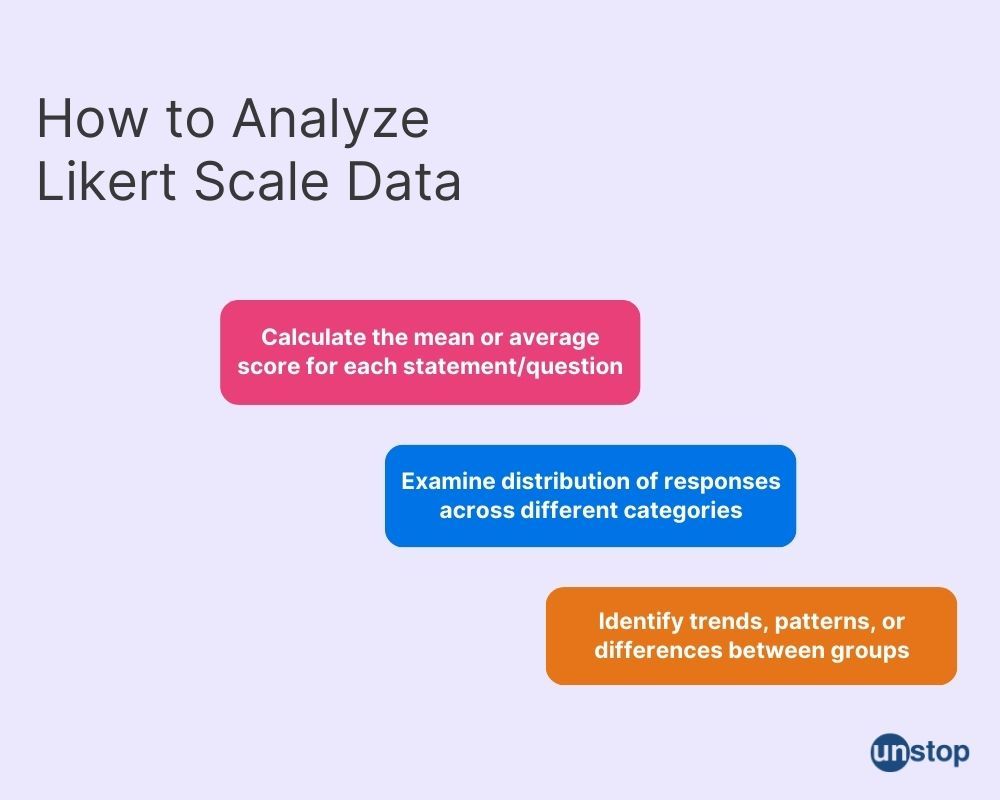
Calculate the mean or average score for each statement/question.
To analyze and interpret Likert scale surveys, one of the first steps is to calculate the mean or average score for each statement or question. This helps provide an overall understanding of respondents' sentiments or opinions on a particular topic.
The mean score is determined by summing up all the individual scores and dividing it by the total number of respondents. For example, if a Likert scale question has options ranging from 1 to 5, with 1 being "strongly disagree" and 5 being "strongly agree," calculating the mean will give us an idea of how participants generally feel about that statement.
Examine the distribution of responses across different categories.
Another crucial aspect in analysing Likert scale data is examining the distribution of responses across different categories. This involves looking at how participants' answers are distributed among various response options. It allows researchers to identify trends, patterns, or significant differences between groups.
By observing this distribution, we can gain insights into whether there is a consensus among respondents or if opinions are more divided. For instance, if most participants select options towards one end (e.g., "agree" or "disagree"), it suggests a strong sentiment towards that viewpoint.
Identify trends, patterns, or significant differences between groups.
Analysing Likert scale data also entails identifying trends, patterns, or significant differences between different groups. Researchers often want to understand if certain factors influence respondents' perceptions differently based on demographics like age, gender, or location.
By comparing responses across these groups using statistical analysis techniques such as inferential statistics and correlations, we can uncover valuable insights. For example, we may find that younger participants tend to have more positive sentiments compared to older ones when evaluating a product's usability.
When performing a Likert scale analysis, it’s important to consider the following key points:
- Ordinal Data: Likert scale data is considered ordinal, meaning the options have a specific order or ranking. However, the numerical value assigned to each option does not necessarily represent a consistent interval between them.
- Qualitative Measures: Likert scales offer a way to quantify qualitative measures by assigning numerical values to responses. This allows for easier analysis and comparison of data.
- Research and Ratios: Analyzing Likert scale data provides researchers with valuable insights into respondents' opinions, attitudes, or perceptions on various topics. It helps in identifying ratios of agreement or disagreement among participants.
Advanced Models for Analyzing Likert Scale Data
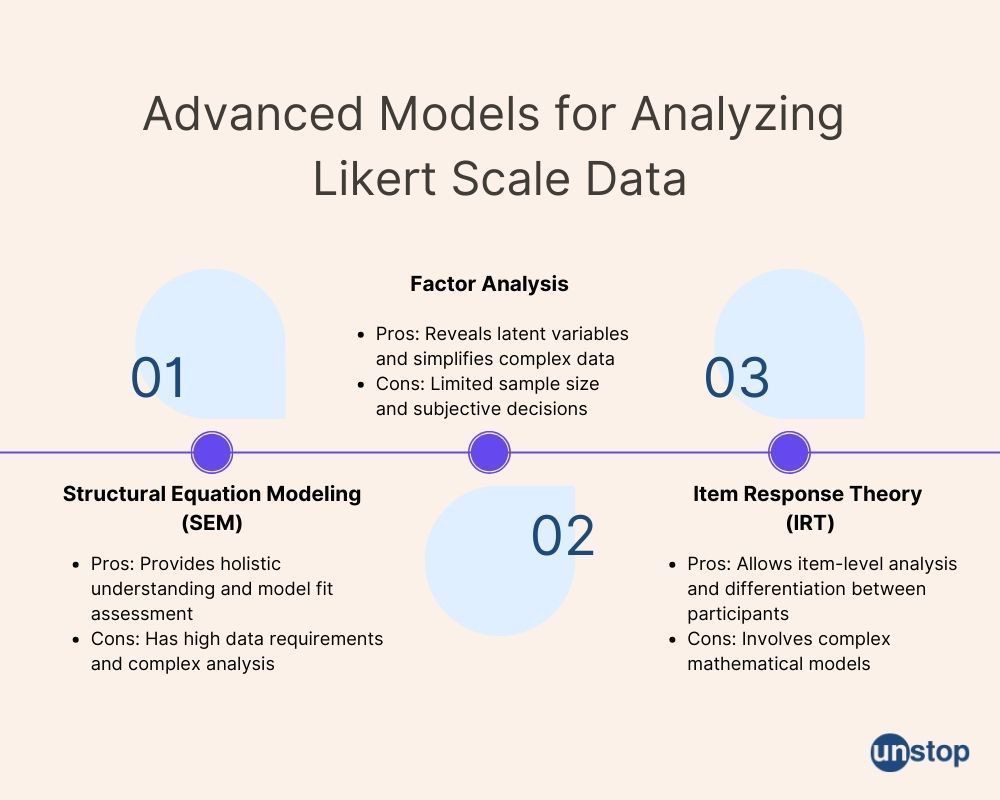
Factor analysis, structural equation modeling (SEM), and item response theory (IRT) are advanced models that can provide deeper insights into Likert scale data.
Factor Analysis: Identifying Underlying Factors
Factor analysis is a powerful statistical technique that helps identify underlying factors or dimensions within a set of Likert scale items. By examining the interrelationships among these items, factor analysis allows researchers to uncover hidden patterns and structures in the data.
Pros of using factor analysis:
- Reveals latent variables: Factor analysis uncovers the latent variables that contribute to participants' responses. For example, in a survey about job satisfaction, factor analysis may reveal underlying factors such as work-life balance, career growth opportunities, and workplace relationships.
- Simplifies complex data: By reducing the number of observed variables into a smaller set of factors, factor analysis simplifies the interpretation of data. This makes it easier to understand and communicate the key dimensions driving participants' responses.
Cons of using factor analysis:
- Subjective decisions: The process of selecting the number of factors or deciding which items belong to each factor requires some subjective judgment. Different researchers may arrive at slightly different results based on their interpretations.
- Limited by sample size: Factor analysis requires an adequate sample size to ensure reliable results. If the sample size is too small, there is a risk of overfitting or obtaining unstable estimates.
Structural Equation Modeling (SEM): Testing Complex Relationships
Structural equation modeling (SEM) goes beyond simple correlation analyses by allowing researchers to test complex relationships between multiple variables simultaneously. It enables us to examine both direct and indirect effects among variables in a comprehensive framework.
Pros of using SEM:
- Holistic understanding: SEM provides a holistic view of how different variables interact with one another. Researchers can examine not only direct effects but also indirect effects mediated through other variables.
- Model fit assessment: SEM allows for model fit assessment, which helps researchers evaluate how well the proposed model fits the observed data. This ensures that the model accurately represents the relationships among variables.
Cons of using SEM:
- Complex analysis: SEM requires a solid understanding of statistical concepts and assumptions. It may be challenging for researchers without advanced statistical knowledge to correctly specify and interpret the models.
- Data requirements: SEM typically requires a larger sample size compared to other statistical techniques. Adequate sample sizes are necessary to obtain reliable estimates and ensure accurate model fitting.
Item Response Theory (IRT): Analyzing Individual Item Characteristics
Item response theory (IRT) provides insights into the difficulty and discrimination of individual Likert scale items. It focuses on analyzing how participants' responses vary based on item characteristics.
Pros of using IRT:
- Item-level analysis: IRT allows researchers to analyze individual items rather than aggregating responses across all items. This provides a more detailed understanding of each item's contribution to overall measurement.
- Differentiates between participants: IRT takes into account participants' abilities or traits when evaluating their responses. It can differentiate between individuals with different levels of proficiency or attitudes towards specific items.
Cons of using IRT:
-
Complexity: IRT involves complex mathematical models that require specialized software for analysis. Researchers need to have a strong understanding of these models and their assumptions.
Likert Scale Analysis: Benefits & Limitations
Benefits of Utilizing Likert Scales
The use of Likert scales offers several benefits in gathering accurate results:
- Efficiency: Using predefined response options saves time compared to open-ended questions.
- Standardization: The consistent format of Likert scales ensures uniformity in data collection.
- Quantification: The numerical nature of Likert scale responses allows for easy quantification and statistical analysis.
- Flexibility: Researchers have the flexibility to design scales with varying numbers of response options based on their specific needs.
- Wide Range of Applications: From customer satisfaction surveys to employee feedback assessments, Likert scales find applications across diverse fields.
Understanding Limitations
While Likert scales offer numerous advantages, it's important to be aware of their limitations:
- Subjectivity: Likert scale responses are subjective and influenced by individual biases and interpretations.
- Limited Response Options: The fixed number of response options may not capture the full range of opinions or attitudes.
- Context Dependency: Responses can vary depending on the context in which questions are asked, potentially impacting the validity of results.
Conclusion
In wrapping up our exploration of the Likert Scale, it's evident that this tool is invaluable in the realm of research, offering a nuanced lens through which we can understand people's attitudes, experiences, and opinions. Its widespread recognition and ease of use encourage high response rates, enhancing the reliability of research findings.
To effectively harness the power of the Likert Scale, researchers must navigate its complexities with a critical eye. By understanding its types, appreciating its benefits, recognizing its limitations, and employing thoughtful analysis strategies, the Likert Scale becomes an indispensable tool in the researcher's arsenal. It bridges the gap between qualitative nuances and quantitative rigor, providing insights that are not only statistically significant but also rich in context and depth.
Frequently Asked Questions (FAQs)
1. How many response options should I include in my Likert scale?
The number of response options depends on the level of granularity you require for your research. While there is no fixed rule, it's generally recommended to have at least five or seven response options on a bipolar scale (ranging from strongly disagree to strongly agree) or a unipolar scale (ranging from not at all likely to extremely likely). This allows respondents enough flexibility without overwhelming them.
2. Can I use Likert scales in online surveys?
Absolutely! In fact, online surveys are an ideal platform for implementing Likert scales due to their ease of administration and automated data collection. There are numerous online survey tools available that offer pre-built question templates with customizable Likert scale options.
3. Is it necessary to provide a neutral option in a Likert scale survey?
Including a neutral option (e.g., neither agree nor disagree) can be beneficial as it allows respondents to express neutrality or uncertainty towards the statement being presented. However, it's important to consider the context and research objectives. In some cases, omitting a neutral option may encourage respondents to provide more decisive responses.
4. How should I analyze Likert scale data?
Analyzing Likert scale data often involves calculating descriptive statistics such as mean, median, and mode to determine the central tendency of responses. You can use inferential statistical techniques like chi-square tests or t-tests to identify significant differences between groups. It's crucial to choose the appropriate analysis method based on your research question and consult with a statistician if needed.
5. Can I compare Likert scale data from different surveys or time periods?
Yes, you can compare Likert scale data from different surveys or time periods by ensuring that the questions and response options remain consistent. This allows for meaningful comparisons over time or between groups. However, it's essential to consider any contextual changes that might influence the results and interpret them accordingly.
6. Are there any alternatives to the Likert scale?
While Likert scales are widely used due to their simplicity and versatility, there are other scaling methods available, such as semantic differential scales (using bipolar adjectives) or visual analog scales (using a continuous line). These alternative scaling techniques offer different approaches for capturing respondents' opinions and attitudes.
Suggested Reads
- Economies Of Scale: Definition, Types, Benefits & Examples
- What is Recession? Delving Deeper Into The Causes With Examples
- What Is A Bear Market?: A Detailed Guide To Navigating It Along With Investing Tips
- The Difference Between Wholesale And Retail Explained (With Examples)
- Brand Awareness A To Z: Comprehensive Guide For New Businesses
I’m a reader first and a writer second, constantly diving into the world of content. If I’m not writing or reading, I like watching movies and dreaming of a life by the beach.
Login to continue reading
And access exclusive content, personalized recommendations, and career-boosting opportunities.
Subscribe
to our newsletter
















Comments
Add comment